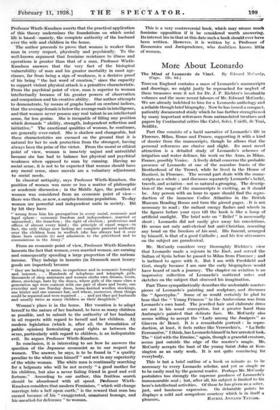More About Leonardo
The Mind of Leonardo da Vinci. By Edward McCurdy: (Cape. 12s. 6d.) THOUGH England contains a mass of Leonardo's manuscripts and drawings, we might justly be reproached for neglect of these treasures were it not for Dr. J. P. Richter's invaluable volumes and the more recent labours of Mr. Edward McCurdy. We are already indebted to him for a Leonardo anthology and a reliable though brief biography. Now he has issued a compact, patiently documented study which he has farther strengthened by many important references from untranslated treatises and papers by Continental critics like Calvi, Solvi, Uzielli, de Toni, Seidlitz.
Part One consists of a lucid narrative of Leonardo's life in Florence, Milan, Rome and France, supporting it with a kind of dossier from the manuscripts, though he allows that the personal references are elusive and slight. Its most novel attraction is a detailed study of Leonardo's schemes of irrigation and water defence, his work on the Arno, in Milan, France, possibly Venice. A lively detail concerns the probable presence of Leonardo at one of the macabre feasts of the Brotherhood of the Trowel, while he lived in the House of Rusticci, in Florence. The second part deals with the manu- scripts as a whole ; and discusses separately Leonardo's belief, travels, and aviation—not so natural a grouping. The descrip- tion of the range of the manuscripts is exciting, as it should be. Any person with an hour to spare should find the repro- duction of the immense Codiee Atlantico in the British Museum Reading Room and turn the pieced pages. It is not necessary to read ; the radiant energy flashes and wheels in the figures before your eyes till the book is like a lamp of artificial sunlight. The brief note on " Belief " is necessarily short ; Leonardo did not easily give away his convictions. He seems not only anti-clerical but anti-Christian, resenting any bond on the freedom of his soul. His funeral, arranged by himself, is that of a good Catholic ; and his few utterances on the subject are paradoxical.
Mr. McCurdy considers very thoroughly Richter's view that Leonardo made a sojourn in the East, and served the Sultan of Syria before he passed to Milan from Florence ; and is inclined to agree with it. But I am with Freshlield and Gori, simply because I am sure the early biographers would have heard of such a journey. The chapter on aviation is an impressive collection of Leonardo's scattered notes and sketches on the subject that obsessed his imagination.
Part Three sympathetically describes the undeniable master- pieces of Leonardo's painting and sculpture, and discusses the " Apocrypha." Some of us would certainly be glad to hear that the " Young Princess " in the Ambrosiana was from Leonardo's own hand. The jewelled hair and elaborate dress are not in his usual conception, but a greater hand than Ambrogio's painted that delicate face. Mr. McCurdy also seems willing to accept the " Lady among the Junipers " as Ginevra de' Benci. It is a remarkable portrait : in repro- duction, at least, it feels rather like Verrocchio's. " La Belle Ferronniere," I think, has Leonardo himself in her arrested look. The " Girl with the Ermine," again, though a graceful creature, seems just outside the edge of the master's magic. Mr. McCurdy accepts the bust of the young Saint John at Ken- sington as an early work. It is not quite convincing for everybody.
This is but a brief outline of a book so minute as to be necessary to every Leonardo scholar, and yet so simple as to be easily read by the general reader. Perhaps Mr. McCurdy postulates too strongly the supreme goodness of Leonardo's immeasurable soul ; but, after all, his subject is limited to his hero's intellectual activities. Of these he has given us a sober, just, and luminous expression. On debatable points he displays a mild and scrupulous courtesy which is in itself a






































 Previous page
Previous page